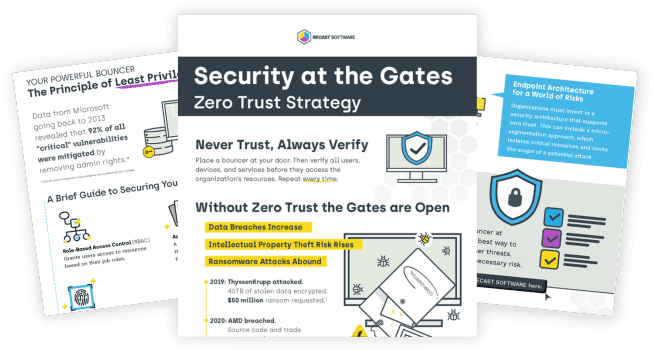Application Management and Patching
Enhancing Cybersecurity: Meeting the ACSC Essential Eight Standards
Are you an attractive target to cybercriminals? If you’re uncertain about the answer here, it’s high time you reassessed your organization’s cybersecurity strategy. Adopting the Essential Eight mitigation strategies is not just a recommendation—it’s a must.
What are The Essential Eight?
Crafted by the Australian Cyber Security Centre (ACSC), they are eight baseline strategies recommended for protecting your organization against a multitude of cyber threats. These strategies encompass application control, patching applications and operating systems, restricting administrative privileges, and more.
The Essential Eight
- Use application control to prevent the execution of malicious programs.
- Patch applications and use the latest versions of applications.
- Configure Microsoft Office macro setting to block macros from the internet and only allow vetted macros.
- Implement user application hardening, including configuring web browsers and disabling unneeded application features.
- Restrict administrative privileges to operating systems and applications based on user duties.
- Patch operating systems and use the latest version of the operating system.
- Set up multi-factor authentication for all users when they perform a privileged action or access an important data repository.
- Set up and perform regular backups of important new/changed data, software, and configuration settings.
Three tools developed by Recast Software, Application Manager, Privilege Manager, and Right Click Tools, help guide your organization towards meeting multiple ACSC recommendations from the Essential Eight list: Strategies 2, 4, 5, and 6.
Enhanced Security and User Productivity with Privilege Manager
Privilege Manager removes unnecessary permissions, thereby preventing users from inadvertently triggering security issues—such as installing unapproved software or clicking malicious links. This aligns with the fourth strategy in the ACSC’s Essential Eight list, user application hardening, which involves configuring web browsers and disabling unneeded application features.
Additionally, Privilege Manager increases productivity. Users no longer need to wait for authorization from the service desk for simple tasks. The permissions are pre-configured, enabling users to access them in a controlled and limited manner, which directly aligns with the fifth strategy of the Essential Eight list: Restrict administrative privileges to operating systems and applications based on user duties. Privilege Manager restricts admin access while ensuring users can work seamlessly and securely on their assigned tasks.
Privilege Manager also decreases the number of service desk tickets as it provides users with safe access required for their tasks. This not only leads to a more efficient workflow, but also saves considerable time and resources.
Privilege Manager also expedites equipment deployment across your enterprise. It employs predefined user profiles, which eliminates the burden of creating and applying individual profiles.
Efficient Application Deployment and Management with Application Manager
Strategy 2 of the Essential Eight—patching applications and using the latest versions—is where Application Manager shines. With its robust features for application packaging, deployment, management, and notification, it ensures your enterprise is running the most recent and secure versions of your applications.
Application Manager helps streamline the deployment process and provides real-time notifications of any needed updates or patches, thereby mitigating potential vulnerabilities. It also eases the application packaging process, which often requires whole patch teams to manage and introduces human error. Application Manager enhances overall security and operational efficiency by automating the monitoring and implementation of patching.
Streamlined Patching and OS Management with Right Click Tools
Any cybersecurity strategy requires operating system management and patching, the 6th pillar of the ACSC’s Essential Eight. Right Click Tools provides a dynamic and efficient solution to meet this challenge.
With Right Click Tools, managing and rolling out OS software updates becomes a streamlined process rather than a frustration. Specifically, it helps you locate devices that are behind on updates and provides information on why the update failed. Right Click Tools also enables IT teams to take quick action and kick off the update remotely. Rather than spending valuable time and resources monitoring and applying updates, Right Click Tools makes it much easier to implement successful updates and maintain the latest operating system versions across your enterprise.
Conclusion: Enhancing Cybersecurity with Recast Software
Implementing Recast Software’s Privilege Manager and Application Manager will empower your organization to meet and maintain critical cybersecurity standards outlined in the ACSC Essential Eight. Enhance your cybersecurity, improve user productivity, and create a more secure, robust operational environment with Recast Software.
Find out more about how Recast Software can help protect your organization here.



































